Self-reported glaucoma prevalence and related factors, contribution to reported visual impairment, and functional burden in a cross-sectional study in Colombia
Castellanos-Perilla, Nicolás; Garcia-Cifuentes, Elkin; Pineda-Ortega, Juliana; Lema, Sofia; Gelvis, Geronimo; Cano-Gutierrez, Carlos Alberto; Mejia-Vergara, Alvaro J.
Journal article, Peer reviewed
Published version

Åpne
Permanent lenke
https://hdl.handle.net/11250/3109329Utgivelsesdato
2023Metadata
Vis full innførselSamlinger
- Department of Clinical Medicine [2066]
- Registrations from Cristin [9791]
Sammendrag
Purpose
Describe the self-reported prevalence of glaucoma in Colombian older adults, emphasizing the most important risk factors and associated daily-life functional alterations.
Methods
This a secondary analysis of the Health, Wellness, and Aging survey conducted in the year 2015. Diagnosis of glaucoma was obtained from self-report. Functional variables were assessed through activities of daily living questionnaires. A descriptive analysis followed by bivariate and multivariate regression models adjusting for confounding variables was conducted.
Results
Self-reported prevalence of glaucoma was 5.67%, with higher rate in women, OR 1.22 (1.13–1.40) p = .003, older age OR 1.02 (1.01–1.02) p < .001, and with higher education OR 1.38 (1.28–1.50) p < .001. Glaucoma was independently associated with diabetes OR 1.37 (1.18–1.61) p < .001 and hypertension 1.26 (1.08–1.46) p = .003. It also showed statistically significant correlations with poor SRH OR 1.15 (1.02–1.32) p < .001, self-reported visual impairment 1.73 (1.50–2.01) p < .001, and impairment in money management OR 1.59 (1.16–2.08) p = .002, grocery shopping OR 1.57 (1.26–1.96) p < .001 and preparing meals OR 1.31 (1.06–1.63) p = .013 and having had falls during the last year OR 1.14 (1.01–1.31) p = 0.041.
Conclusion
Our findings suggest the self-reported prevalence of glaucoma in older adults in Colombia to be higher than reported data. Glaucoma and visual impairment in older adults represent a public health concern, since glaucoma was associated with adverse outcomes like functional loss and risk of falling, affecting the quality of life and their participation in society.
